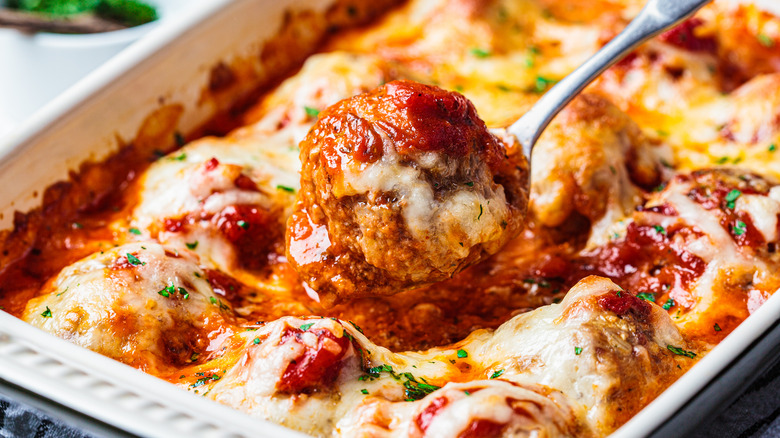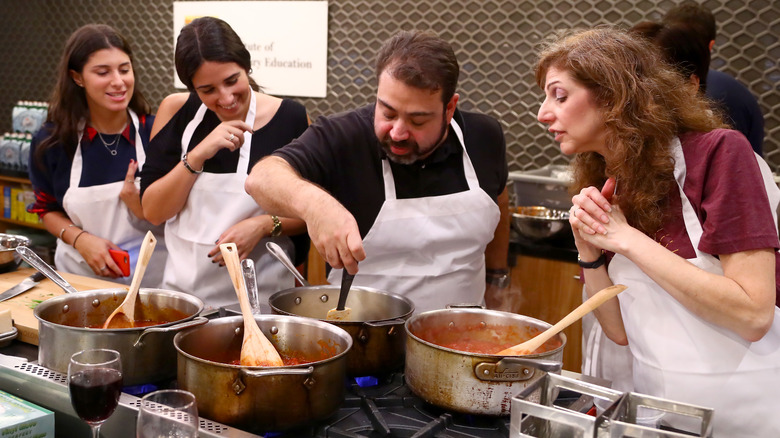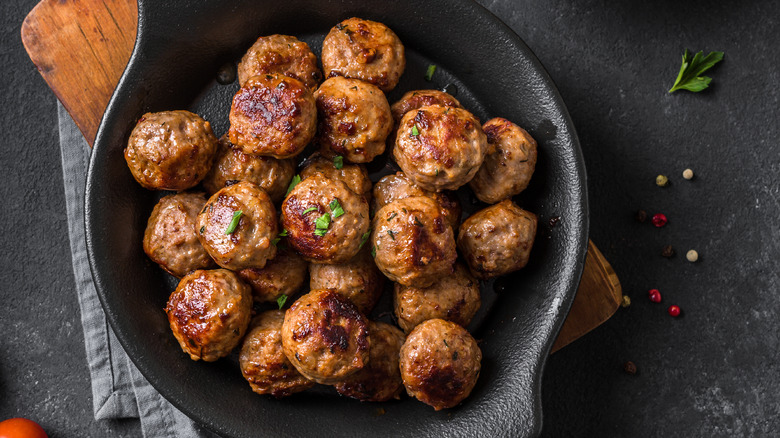The Fast And Easy 'Drop Method' For Making Meatballs
Not many things are as ubiquitous in culinary traditions around the world as meatballs. From Little Italy to IKEA, ground meat with seasonings reformed into bite-sized morsels smothered in a sauce is always a sure-fire comfort food. One theory (according to Munchery) on the origins of meatballs links their parentage to the dish kofta from ancient Persia, which then was spread to Europe and Asia via the Arab empires. Because they have been spread to nearly every culture, there are a lot of differing opinions on how best to prepare meatballs. Dishes like kofta are usually browned over an open flame in the kebab style before simmering in a spiced sauce. Other methods in Asia mince the meat into a really fine paste before simmering them in a soup broth. And some recipes from Eastern and Northern Europe bread and deep fry the meatballs, similar to a chicken-nugget style appetizer.
Everyone has their special approach to making the perfect meatball: what kind of meat to use, fat-to-lean meat ratios, what spice blends, and what kind of sauce base pairs best, but when it comes to the classic "Lady and the Tramp"-style Americanized spaghetti and meatballs, one time-conscious cooking trick can help you get the most tender meatballs and the most flavorful sauces.
What is the drop method
A good way to get the most from your meatballs without running the risk of drying them out is the drop method: putting the meatballs directly in the cold sauce without pre-browning, and bringing everything to temperature together. Also known as poaching, the drop method cooks submerged meatballs in the sauce as it's brought to a simmer, effectively cooking the meat to tender perfection and allowing the melted fats to infuse with the sauce itself (via Greatist). The benefit of poaching is that using a simmering liquid (rather than a direct cooking surface) avoids scorching and burning the meatball while still cooking it all the way through.
Another benefit of the drop method is that it makes the entire meal preparation process a bit easier. There are a handful of other methods for preparing meatballs, all with their won merits and drawbacks, but none of them offer the time convenience and effectiveness of the drop method. Some would insist that the optimal cooking method for premium meatballs is braising, a method that initially browns the meat, then adds aromatics, seasonings, and braising liquid to similarly simmer-cook the meatballs. However, the braising process can be tedious, time-consuming, and risky, potentially yielding meatballs that are tough and gritty if over-seared. Other methods that brown meatballs in a frying pan or in an oven not only risk over-cooking but also expunge all the fat within the meat that could otherwise help flavor the sauce.
When to brown, and when to drop
The drop method is great for one-pot meals and preparing hors d'oeuvres, but in order to keep the meat tender, this method sacrifices the meatball's structural integrity. This usually isn't a problem in the traditional Italian-American bistro style, as some meatballs will break apart and contribute to the overall flavor and texture of the sauce. But in many other meatball recipes, the structural integrity of the meatball has a higher priority. Many meatball cooking methods require some degree of browning in order to develop a crust that helps the meatball keep a nuggety shape.
Optimal cooking methods vary depending on the intended role of your meatball. For dishes where the meatball is smothered in a marinara, served in a broth, or are otherwise complimentary to a gravy, the drop method is best because it give the meatball time to affect and absorb some of the flavors of the sauce. However, if your dish is intended to highlight the flavors of the meatball by pairing it with a fun dipping sauce like tzatziki or fruit jam, it's important that the meat is either fried, roasted, or grilled to develop the outer crust. This both helps the meatball keep its shape, and locks in the natural juices of the meat.


